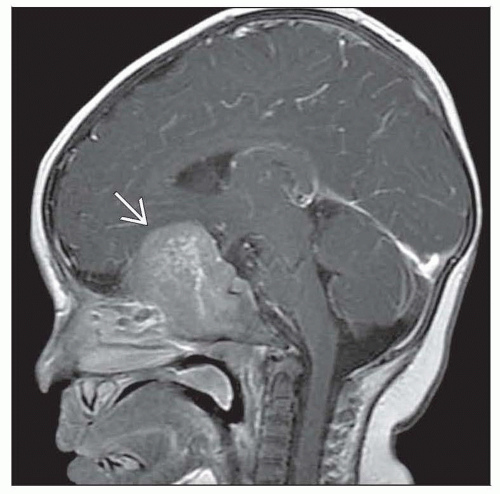Peripheral Primitive Neuroectodermal Tumor (Ewing Sarcoma)
Fausto J. Rodriguez, MD
Key Facts
Terminology
Unrelated to intraparenchymal CNS PNETs
Etiology/Pathogenesis
Somatic rearrangements in EWS gene result in fusion transcripts with aberrant transcriptional, protumorigenic activity
Clinical Issues
In CNS, secondary extension from epidural space, skull bones, or metastases to spine most common
Primary dural locations intracranially or in spine (extraaxial)
Aggressive neoplasms, but long-term survival in patients with localized disease in recent years
Microscopic Pathology
Sheets or lobules of cells with round to oval nuclei and variable cytoplasm
Ancillary Tests
Various fusion transcripts, usually involving EWS gene, by RT-PCR or FISH is almost definitional
CD99(+), membranous pattern in majority of cases
Top Differential Diagnoses
Medulloblastoma/CNS primitive neuroectodermal tumors
Pediatric round blue cell tumors
Small cell glioblastoma
Lymphoma
TERMINOLOGY
Abbreviations
Peripheral primitive neuroectodermal tumor (PNET)
Ewing sarcoma (ES)
Definitions
Malignant small round blue cell tumor with rearrangements in EWS gene
Unrelated to intraparenchymal CNS PNETs
ETIOLOGY/PATHOGENESIS
Genetic
Somatic rearrangements in EWS gene result in fusion transcripts with aberrant transcriptional, protumorigenic activity
CLINICAL ISSUES
Site
Favors lower extremities and chest wall in children and teenagers
In CNS, secondary extension from epidural space, skull bones, or metastases to spine most common
Primary locations include
Cauda equina/filum terminale
Intracranial or intraspinal dura (extraaxial)
Peripheral nerve
Treatment
Irradiation and multiagent chemotherapy
Prognosis
Aggressive neoplasms, but long-term survival in patients with localized disease in recent years
Some primary intraspinal examples recur with disseminated leptomeningeal disease
IMAGE FINDINGS
MR Findings
Enhancing masses with dural tails may mimic meningioma intracranially
CT Findings
Best demonstrates bone destruction
Stay updated, free articles. Join our Telegram channel

Full access? Get Clinical Tree





